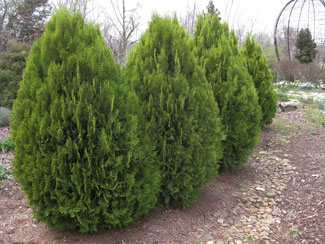Resource Library
Plant of the Week: Golden, Berckmans Arborvitae
The University of Arkansas System Division of Agriculture does not promote, support or recommend plants featured in "Plant of the Week." Please consult your local Extension office for plants suitable for your region.
Plant of the Week
Berckmans Golden Arborvitae
Latin: Thuja orientalis

I find historical connections in the world fascinating. This past week, Adam Scott won he Masters Golf Tournament in Augusta, GA, and I pruned an overgrown row of Berckmans Golden Arborvitae (Thuja orientalis ‘Conspicua’). What, you say, could be the possible connection between these seemingly unrelated events?
Berckmans Golden Arborvitae is a dwarfish, much-branched Asian arborvitae that grows 12-to-15 feet tall and 10 feet wide with the form of the spade in a pack of playing cards. It has decidedly flattened hands of foliage held upright with tiny, scale-like needles clasping the stem. The new growth produced in full sun is a bright yellow with shaded and interior portions of the plant green. The golden color of the foliage fades some as the summer progresses but overall the plant has good golden color retention throughout most of the summer. The seed cone is a roundish, bluish-yellow, .75-inch long affair with a series of curved horns protruding from each scale.
The various clones of the oriental arborvitae have been grown in western gardens since being introduced from China in the middle years of the 18th century. The golden forms were amongst the first introduced and quickly became popular in the long, drab winters of northern Europe where Dutch, Flemish, and French nurserymen began making selections from seedlings they grew. One of these was dubbed ‘Conspicua’, a compact, golden colored form that, while smaller than the typical form, is still pretty big. Calling Berkmans Golden Arborvitae a dwarf is akin to referring to a “smallish elephant.”
Prosper J. Berckmans (1830 – 1910) was born in Belgium but immigrated to the United States in 1850. He was trained in botany and horticulture in Belgium and France so it was only natural that he started producing nursery plants in his newly adopted country. He spent seven years in New Jersey before moving to Augusta, Georgia where he started Fruitland Nursery, the most important nursery in the South during the 19th century.
Berkmans started out with 25 acres of nursery stock and built his operation to considerable size during his long and productive career. Fruit tree production was an important part of the nursery and Berckmans is considered the father of peach production in Georgia. However, he was interested in a wide array of plants, including ornamentals, and is credited with being the nurseryman who popularized the large, showy Indica azaleas that still give the Deep South its signature look. To this list we can add Berckmans Golden Arborvitae – a plant he called Biota aurea nana, and though he didn’t originate it, he popularized it in this country. Nurserymen quickly realized the sales potential of Berckmans’ plant so they began calling it Berckmans Golden Arborvitae, a name that stuck even though it is not technically correct.
After Berckmans’ death the nursery continued for another generation, but in the1930s golfing legends Bobby Jones and Clifford Roberts wanted to build a world-class golf course. They soon were offered the old Fruitlands Nursery site in Augusta with its collections of azaleas and oak trees that have helped make it one of the most storied of American courses. Alphonse, a son of P. J. Berckmans, helped design the course.
Berckmans Golden Arborvitae is an easy to grow plant that has lost some of its luster as a landscape shrub because it is too squatty to fit into many landscape situations. Perhaps best used as a pruned hedge or an informal background planting for windbreak or screening. It tolerates most average garden soils and, though well suited to dry conditions, is not tolerant of extreme drought conditions. Like all junipers and arborvitaes it is susceptible to bagworm attack in the summer.
By: Gerald Klingaman, retired
Retired Extension Horticulturist - Ornamentals
Extension News - April 19, 2013
The University of Arkansas System Division of Agriculture does not maintain lists of retail outlets where these plants can be purchased. Please check your local nursery or other retail outlets to ask about the availability of these plants for your growing area.